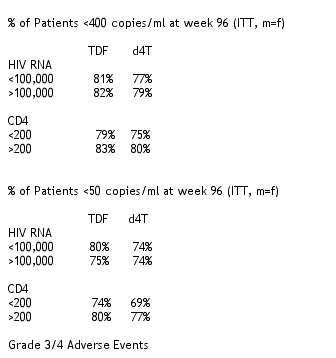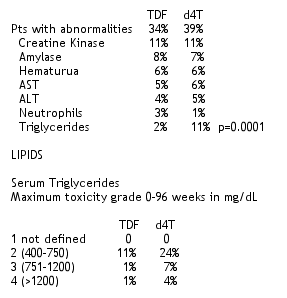 |
 |
 |
| |
Tenofovir vs d4T, week 96; And, Once Daily Therapies
|
| |
| |
Tenofovir vs D4T When Used in Combination with 3Tc and Efavirenz in Treatment Naive Patients: 96 weeks results
Once Daily Regimens in development or approved already: d4T, 3TC, abacavir, nevirapine, atazanavir (PI), 908/r (PI), tenofovir in addition to ddI, efavirenz
Reported by Jules Levin
At the Retrovirus Conference in Boston 2003 Feb 10-14, Schlomo Staszewski and colleagues reported on the 96-week results from this study in which 600 patients were randomized to tenofovir (TDF) or d4T. All patients also received 3TC and efavirenz (EFV). All patients also received d4T or TDF placebo. EFV and TDF are taken once daily and d4T and 3TC were taken twice daily. However, d4T and 3TC are now available to be taken once daily. Abacavir (Ziagen) is in the process of being researched to be taken once daily. And GlaxoSmithKline is researching a once daily pill, which will combine abacavir and 3TC. At this conference data from the 2NN Study found nevirapine once daily to be effective. As you can see there are a number of drugs that can be used once daily, and additional therapies are being researched to be used once daily. The new formulation of amprenavir, 908, is being studied once daily with a boost from a small dose of ritonavir. The once daily 908 regimen is 1400 mg once daily boosted by 200 mg of ritonavir. When 908 is used twice daily the regimen is 700 mg of 908 boosted by 100 mg of ritonavir. The CONTEXT Study was presented at this conference and reported 24-week results comparing these two regimens to Kaletra. Here is the link to that study:
CONTEXT Study: 908 once or twice daily vs Kaletra
http://www.natap.org/2003/Retro/day13.htm
Two Reports on 2NN: nevirapine once daily, twice daily and NVP+EFV
http://www.natap.org/2003/Retro/day14.htm
http://www.natap.org/2003/Retro/day5.htm
Once Daily AZT, d4T
http://www.natap.org/2002/barcelona/day17.htm
FDA Approves d4T Once Daily, Extended Release Formulation
http://www.natap.org/2003/Jan/010103_4.htm
TENOFOVIR vs d4T STUDY 903: 96-week results
600 patients treatment-naive patients were randomized (1:1) to the TDF or d4T regimens. EFV & TDF are administered once daily so this regimen had 2 of 3 therapies taken once daily. In the other regimen both d4T and 3TC were taken twice daily & EFV was taken was daily. Patients were stratified by over or below 100,000 copies/ml at baseline so the results evaluate the effect of both regimens on high or low viral loads. As well, patients were stratified by below or above 200 CD4s so we can evaluate the response by high or low CD4 count, that is, advanced or less advanced HIV disease.
This study found that both study group regimens, d4T and TDF regimens, showed very good and comparable viral load responses at week 96. These good responses were also seen in patients with high viral loads (>100,000) and low CD4 cell counts (<200) before starting therapies. So both regimens were potent. The study found these differences between the TDF and d4T regimens in patients: TDF showed significantly less toxicities associated with mitochondrial toxicity, better overall fasting lipid profile, lower use of lipid lowering agents, more limb far at week 96, and greater weight gain. Both arms showed similar renal safety profile. It would be good to see a study comparing TDF to AZT or abacavir based regimens, where the comparisons might be different in some respects.
Patients were on average 36 yrs old and 158 lbs. 26% were female and 64% were White. About 20% were Black and 7% Hispanic. Average viral load was 81,300 copies/ml in both the TDF and d4T groups. And average CD4 count was 280. 39% of study patients has <200 CD4 counts in both groups.
15% of patients in both groups discontinued therapy and the percentages and reasons were comparable for both the d4T and TDF groups. Only 1-2% discontinued due to adverse events. And only 2% discontinued due to non-compliance.
At week 96, 82% in the TDF group and 78% in the d4T group had <400 copies/ml, undetectable viral load (Intent To treat, missing=Failure). These percentages were relatively steady from the first 16 weeks of the study until week 96. 78% in the TDF group and 74% in the d4T group had <50 copies/ml (ITT, m=f). And again percentages were steady from week 16 to 96.
|
|
 |
| |
23% in both groups had grade 3/4 events. The most common events were low in incidence: rash (2%), bacterial infection (2), depression (2%), fever (2%), pneumonia (1%). In this sense both regimens appear well tolerated.
Grade 3/4 Lab Abnormalities
Again pretty good numbers. Pay attention to tryiglycerides below.
|
|
 |
| |
Fasting triglycerides increased 5 mg/dL in the d4T arm and 103 in the TDF arm from baseline to week 96. (p<0.001)
Fasting cholesterol increased 30 mg/dL in the TDF group and 51 in the d4T group. (p<0.001)
Fasting HDL and LDL increased in both arms but more in the d4T group. LDL increased 20 mg/dL in the d4T group and 10 mg/dL in the TDF group (p<0.001). HDL increased about 7 mg/dL in the d4T group and a the increase was a little more in the TDF group, about 9 mg/dL. The difference was significant (p=0.032).
The time to first use of a lipod lowering agent was shorter in the d4T group. At week 96 10% in the d4T group had used a lipod lowering agent and 2% did so in the TDF group. By about week 32 the percent of patients using such an agent in the d4T started to increase.
The researchers reported toxicities potentially associated with mitochondrial dysfunction through week 48. 7% of patients in the d4T group developed peripheral neuritis/neuropathy compared to 3% in the TDF group (p=0.013). 4% in the d4T group reported investigator defined lipodystrophy compared to 1% in the TDF group but this difference was not signifiicant. 1% in the d4T group reported lactic acidosis vs 0 in the TDF group, also investigator defined. And the percent reporting pancreatitis was 0 in both groups.
Patients receiving TDF regimen reported gaining more weight (6 lbs vs 1 lb, p=-.002).
Total limb fat was greater in the TDF group at week 96 compared to the patients in the d4T group (18 lbs vs 11 lbs, p<0.001).
Venous lactate: The upper limit of normal is 2.2 and 4% in the TDF group and 14% in the d4T group had >2.2.
Serum Creatinine for patients on TDF: 10 patients (3%) had >0.4 increase from baseline. <1% had 2.1-3.0. And 0 had >3.1 or >6.0.
Serum phosphorous: There was no difference between this in both groups. Nine patients (3%) had 2.0 to <2.2. Eight patients (3%) had 1.5 to 1.9. <1% had 1.0 to 1.4, and 0 had <1.0.
OSTEOEPENIA/OSTEOPOROSIS
They followed 125 patients. 46% had osteopenia by DXA using the WHO criteria at baseline. Duration of HIV infection and "classic" risk factors were strongly associated with osteopenia. Bone mineral density (BMD) slightly increased during follow-up of 93 patients for 72 weeks.
HIV Disease Associated with Osteopenia
24% of patients were osteopenic at the lumbar spine before therapy (p=0.007). 23% were osteopenic at the femoral neck (p=0.011).
Over the course of 96 weeks spine BMD decreased by -1,6 in the d4T group and -2.3 in the TDF group. Hip BMD decreased -2.0 in the d4T group and -3.4 in the TDF group by week 96. There were 7 fractures in the d4T group and 1 in the TDF group. All fractures involved significant trauma.
The authors concluded TDF showed significantly less toxicities associated with mitochondrial toxicity, better overall fasting lipod profile, lower use of lipid lowering agents, more limb far at week 96, and greater weight gain. Both arms showed similar renal safety profile.
There were two posters at Retrovirus reporting on renally associated adverse events in a small percent of patients on TDF:
http://www.natap.org/2003/Retro/day16.htm
|
|
| |
|
 |
 |
|
|